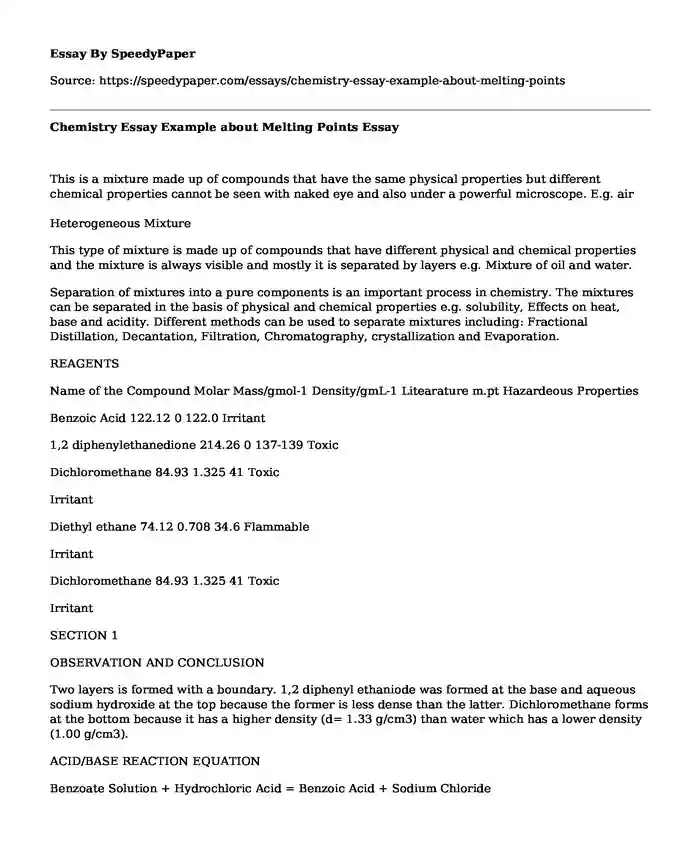This is a mixture made up of compounds that have the same physical properties but different chemical properties cannot be seen with naked eye and also under a powerful microscope. E.g. air
Heterogeneous Mixture
This type of mixture is made up of compounds that have different physical and chemical properties and the mixture is always visible and mostly it is separated by layers e.g. Mixture of oil and water.
Separation of mixtures into a pure components is an important process in chemistry. The mixtures can be separated in the basis of physical and chemical properties e.g. solubility, Effects on heat, base and acidity. Different methods can be used to separate mixtures including: Fractional Distillation, Decantation, Filtration, Chromatography, crystallization and Evaporation.
REAGENTS
Name of the Compound Molar Mass/gmol-1 Density/gmL-1 Litearature m.pt Hazardeous Properties
Benzoic Acid 122.12 0 122.0 Irritant
1,2 diphenylethanedione 214.26 0 137-139 Toxic
Dichloromethane 84.93 1.325 41 Toxic
Irritant
Diethyl ethane 74.12 0.708 34.6 Flammable
Irritant
Dichloromethane 84.93 1.325 41 Toxic
Irritant
SECTION 1
OBSERVATION AND CONCLUSION
Two layers is formed with a boundary. 1,2 diphenyl ethaniode was formed at the base and aqueous sodium hydroxide at the top because the former is less dense than the latter. Dichloromethane forms at the bottom because it has a higher density (d= 1.33 g/cm3) than water which has a lower density (1.00 g/cm3).
ACID/BASE REACTION EQUATION
Benzoate Solution + Hydrochloric Acid = Benzoic Acid + Sodium Chloride
SECTION 4
OBSERVATION
When dilute aqueous solution of sodium Hydroxide (NaOH) is added to a mixture of Benzyl and Benzoic acid in a flask that is fitted with stopcock, then the flask is shaken and allowed to settle thereafter two layers will form where one is a layer of dichloromethane and the other aqueous layer will be at the top.
CONCLUSION
Dichloromethane forms at the bottom because it has a higher density (d= 1.33 g/cm3) than water which has a lower density (1.00 g/cm3).
ACID/BASE REACTION EQUATION
SECTION 5
Benzoic Acid + 1,2 diphenyl ethanedioneDissolved in Dichloromethane
Use of separatory funnel
Aqueous Phase
Sodium Benzoate
1,2 diphenyl ethanedione Organic Phase
Precipitate of benzoic acid
Crude solid 1,2 diphenyl ethanedione Evaporate the solvent Acidify Section
Crystals of 1,2 diphenyl ethanedione Recrystallize
OBSERVATION
The two solvent were allowed to separate back into two layers because after shaking, one compound ends up in the dichloromethane layer and the other component ends up in the water layer resulting in the neutral organic compound benzyl remaining in the organic dichloromethane layer and benzoic acid being extracted in the aqueous sodium hydroxide layer as its conjugate base. Later the stopcock was opened and then drained the lower organic layer that contains benzyl into a beaker.
Conclusion
In this way the two organic components was successfully separated.
ACID/BASE REACTION
Heat to Standard Temperature
Benzoic Acid Solution Pure colourless Crystal
Of 122 degrees centigrade Solid dry benzoic acid
SECTION 6
FLOWCHART
OBSERVATION
When a small quantity of dichloromethane was added to the impure solid of benzyl and heated then cooled a crystal product of benzyl was formed with impurities upon using vacuum filtration, the impurities were removed a pure dry solid of benzyl was found.
CONCLUSION
The Purification of benzyl through recrystallization was possible because of the fact that benzyl has different solubility in different solvent at different temperatures thus making it possible to remove impurities using this properties.
ACID/BASE REACTION
RESULTS
Mass of Benzoic acid
Mass of weigh boat = 2.2053g
Mass of weigh + Benzoic acid = 2.6053g
Mass of Benzoic Acid = 0.4g
Calculation of % recovery of Benzoic Acid
= (0.4/0.5) * 100%
= 80 %
Melting Point Determination of Benzoic Acid
Temperature 1 slow = 108 degrees centigrade
Temperature 2 slow = 120 degrees centigrade
Melting Point Range of Benzoic acid = 121-123 degrees centigrade
Melting Point of Benzoic acid= 122 degrees centigrade
Appearance of Benzoic acid crystals = Solid colourless dry Crystals
Mass of recrystallized 1,2 diphenyl ethandione
Mass of weigh boat = 2.2053g
Mass of weigh boat + 1,2 diphenyl ethandione = 3.1053g
Mass of 1,2 diphenyl ethandione = 0.9 g
Appearance of 1,2 diphenyl ethandione
Crystals = Yellow Crystals
Calculation of % mass recovery of 1,2 diphenyl ethandione
Remember that the maximum recovery possible is 1.00 grams because you combined two samples (yours and your partners)
= (0.9/1) * 100
= 90%
Conclusion
Melting points are usually expressed as a range between when materials begin to melt and when it has completely melted. Pure compounds characteristically have a sharp melting range while most mixed or impure compounds have a broad melting range. Another characteristic of melting points is their depression upon introduction of impurities or mixing. In our case the lower melting point of the impurity lowered the melting point of the benzoic acid from the standard as the temperature increases until it reached the standard i.e. 121-123 degrees centigrade impurities got separated hence producing pure colourless solid of benzoic acid.
Cite this page
Chemistry Essay Example about Melting Points. (2022, Mar 02). Retrieved from https://speedypaper.com/essays/chemistry-essay-example-about-melting-points
Request Removal
If you are the original author of this essay and no longer wish to have it published on the SpeedyPaper website, please click below to request its removal:
- Fast Food Essay Example
- Law Essay Example on Commonwealth
- Essay Example Dedicated to Life Span Development: Adolescence
- Free Essay: The Link Between Business Strategy and Human Resource Management (HRM)
- Free Essay Comparing the Power Structures in The Garden Party and The Voice from the Wall
- Essay Sample: Circ-RNA for Diagnostic Cancer
- Essay sample: Type 2 Diabetes Primary Prevention
Popular categories





